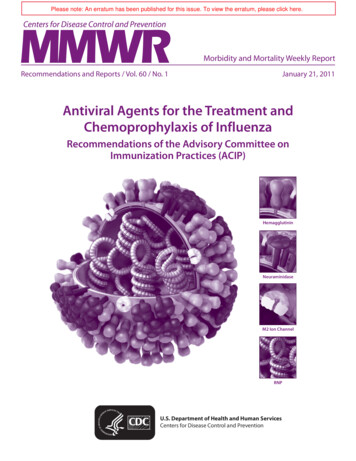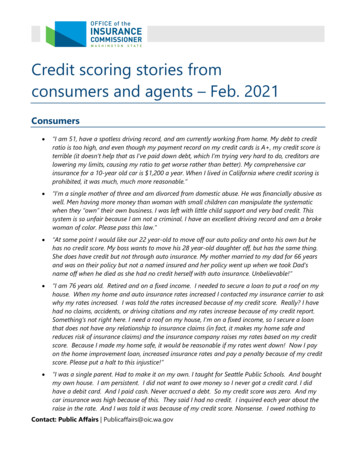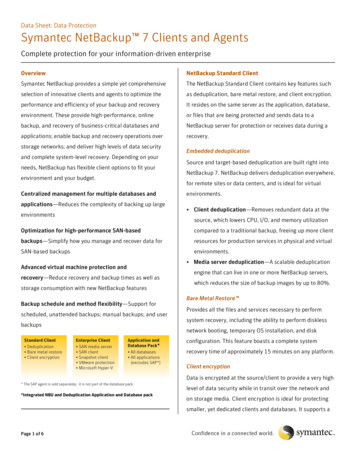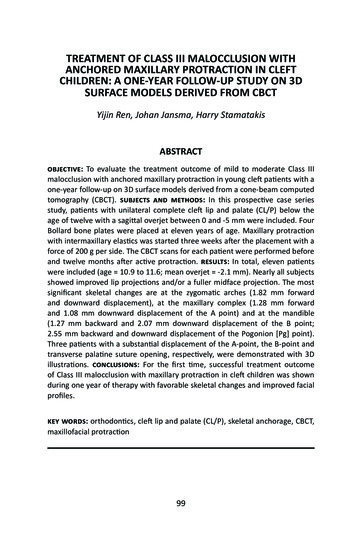
Transcription
Please note: An erratum has been published for this issue. To view the erratum, please click here.Morbidity and Mortality Weekly ReportRecommendations and Reports / Vol. 60 / No. 1January 21, 2011Antiviral Agents for the Treatment andChemoprophylaxis of InfluenzaRecommendations of the Advisory Committee onImmunization Practices (ACIP)HemagglutininNeuraminidaseM2 Ion ChannelRNPU.S. Department of Health and Human ServicesCenters for Disease Control and Prevention
Recommendations and ReportsCONTENTSIntroduction.1Methods.2Primary Changes and Updates in the Recommendations.2Influenza Virus Transmission.3Clinical Signs and Symptoms of Influenza.3Role of Laboratory Diagnosis.4Antiviral Agents for Influenza.6Antiviral Drug Resistance Among Influenza Viruses.6Use of Antivirals.7Dosage. 14Adverse Events . 17Drug Interactions . . 18Emergency Use Authorization. 18Additional Information. 18On the cover: This illustration depicts the influenza A virus. Graphic created by Dan J. Higgins, Division of Communication Services, CDC.The MMWR series of publications is published by Surveillance, Epidemiology, and Laboratory Services, Centers for Disease Control and Prevention (CDC), U.S.Department of Health and Human Services, Atlanta, GA 30333.Suggested Citation: Centers for Disease Control and Prevention. [Title]. MMWR 2011;60(No. RR-#):[inclusive page numbers].Centers for Disease Control and PreventionThomas R. Frieden, MD, MPH, DirectorHarold W. Jaffe, MD, MA, Associate Director for ScienceJames W. Stephens, PhD, Office of the Associate Director for ScienceStephen B. Thacker, MD, MSc, Deputy Director for Surveillance, Epidemiology, and Laboratory ServicesStephanie Zaza, MD, MPH, Director, Epidemiology and Analysis Program OfficeMMWR Editorial and Production StaffRonald L. Moolenaar, MD, MPH, Editor, MMWR SeriesChristine G. Casey, MD, Deputy Editor, MMWR SeriesTeresa F. Rutledge, Managing Editor, MMWR SeriesDavid C. Johnson, Lead Technical Writer-EditorJeffrey D. Sokolow, MA, Project EditorMartha F. Boyd, Lead Visual Information SpecialistMalbea A. LaPete, Julia C. Martinroe,Stephen R. Spriggs, Terraye M. StarrVisual Information SpecialistsQuang M. Doan, MBA, Phyllis H. KingInformation Technology SpecialistsMMWR Editorial BoardWilliam L. Roper, MD, MPH, Chapel Hill, NC, ChairmanPatricia Quinlisk, MD, MPH, Des Moines, IAVirginia A. Caine, MD, Indianapolis, INPatrick L. Remington, MD, MPH, Madison, WIJonathan E. Fielding, MD, MPH, MBA, Los Angeles, CABarbara K. Rimer, DrPH, Chapel Hill, NCDavid W. Fleming, MD, Seattle, WAJohn V. Rullan, MD, MPH, San Juan, PRWilliam E. Halperin, MD, DrPH, MPH, Newark, NJWilliam Schaffner, MD, Nashville, TNKing K. Holmes, MD, PhD, Seattle, WAAnne Schuchat, MD, Atlanta, GADeborah Holtzman, PhD, Atlanta, GADixie E. Snider, MD, MPH, Atlanta, GAJohn K. Iglehart, Bethesda, MDJohn W. Ward, MD, Atlanta, GADennis G. Maki, MD, Madison, WI
Recommendations and ReportsAntiviral Agents for the Treatment and Chemoprophylaxisof InfluenzaRecommendations of the Advisory Committee onImmunization Practices (ACIP)Prepared byAnthony E. Fiore, MDAlicia Fry, MDDavid Shay, MDLarisa Gubareva, PhDJoseph S. Bresee, MDTimothy M. Uyeki, MDInfluenza Division, National Center for Immunization and Respiratory DiseasesSummaryThis report updates previous recommendations by CDC’s Advisory Committee on Immunization Practices (ACIP) regardingthe use of antiviral agents for the prevention and treatment of influenza (CDC. Prevention and control of influenza: recommendations of the Advisory Committee on Immunization Practices [ACIP]. MMWR 2008;57[No. RR-7]).This report containsinformation on treatment and chemoprophylaxis of influenza virus infection and provides a summary of the effectiveness andsafety of antiviral treatment medications. Highlights include recommendations for use of 1) early antiviral treatment of suspectedor confirmed influenza among persons with severe influenza (e.g., those who have severe, complicated, or progressive illness orwho require hospitalization); 2) early antiviral treatment of suspected or confirmed influenza among persons at higher risk forinfluenza complications; and 3) either oseltamivir or zanamivir for persons with influenza caused by 2009 H1N1 virus, influenzaA (H3N2) virus, or influenza B virus or when the influenza virus type or influenza A virus subtype is unknown; 4) antiviralmedications among children aged 1 year; 5) local influenza testing and influenza surveillance data, when available, to help guidetreatment decisions; and 6) consideration of antiviral treatment for outpatients with confirmed or suspected influenza who do nothave known risk factors for severe illness, if treatment can be initiated within 48 hours of illness onset. Additional information isavailable from CDC’s influenza website at http://www.cdc.gov/flu, including any updates or supplements to these recommendations that might be required during the 2010–11 influenza season. Health-care providers should be alert to announcements ofrecommendation updates and should check the CDC influenza website periodically for additional information. Recommendationsrelated to the use of vaccines for the prevention of influenza during the 2010–11 influenza season have been published previously (CDC. Prevention and control of influenza with vaccines: recommendations of the Advisory Committee on ImmunizationPractices [ACIP], 2010. MMWR 2010;59[No. RR-8]).IntroductionIn the United States, annual epidemics of influenza occur typicallyduring the late fall through early spring. Influenza viruses can causedisease among persons in any age group, but rates of illness are highestamong children (1,2). During most influenza seasons, rates of seriousThe material in this report originated in the National Center forImmunization and Respiratory Diseases, Anne Schuchat, MD,Director, and the Influenza Division, Nancy Cox, PhD, Director.Corresponding preparer: Timothy Uyeki, MD, Influenza Division,National Center for Immunization and Respiratory Diseases, CDC,1600 Clifton Road, N.E., MS A-20, Atlanta, GA 30333. Telephone:404-639-3747; Fax: 404-639-3866; E-mail: tuyeki@cdc.gov.illness and death are highest among persons aged 65 years, childrenaged 2 years, and persons of any age who have medical conditionsthat place them at increased risk for complications from influenza(3,4). In addition, data from epidemiologic studies conducted duringthe 2009 influenza A (H1N1) pandemic indicated that the risk forinfluenza complications was also increased among persons who aremorbidly obese (body-mass index [BMI] 40) and American Indians/Alaska Natives (5–8). Influenza illness caused by 2009 pandemicinfluenza A (H1N1) (2009 H1N1) virus is expected to occur duringwinter influenza seasons in the Northern and Southern hemispheres.The extent of influenza activity caused by strains of the two seasonalinfluenza A virus subtypes (seasonal H1N1 and H3N2) that havecocirculated since 1977 and influenza B virus strains is unpredictable,although seasonal H1N1 virus strains have been detected very rarelyMMWR / January 21, 2011 / Vol. 60 / No. 11
Recommendations and Reportsworldwide since 2009. In the postpandemic period, 2009 H1N1virus strains now are considered to be the predominant seasonalinfluenza A (H1N1) virus strains.On the basis of epidemiologic studies of seasonal influenza or 2009H1N1, persons at higher risk for influenza complications include: children aged 5 years (especially those aged 2 years); adults aged 65 years; persons with chronic pulmonary (including asthma), cardiovascular (except hypertension alone), renal, hepatic, hematologic(including sickle cell disease), metabolic disorders (including diabetes mellitus) or neurologic and neurodevelopment conditions(including disorders of the brain, spinal cord, peripheral nerve,and muscle such as cerebral palsy, epilepsy (seizure disorders),stroke, intellectual disability (mental retardation), moderate tosevere developmental delay, muscular dystrophy, or spinal cordinjury) (9); persons with immunosuppression, including that caused bymedications or by HIV infection; women who are pregnant or postpartum (within 2 weeks afterdelivery); persons aged 18 years who are receiving long-term aspirintherapy; American Indians/Alaska Natives; persons who are morbidly obese (i.e., BMI 40); and residents of nursing homes and other chronic-care facilities.For children, the risk for severe complications from seasonal influenza is highest among those aged 2 years, who have much higherrates of hospitalization for influenza-related complications comparedwith older children (3). Medical care and emergency departmentvisits attributable to influenza are increased among children aged 5 years compared with older children (10). Persons aged 18 yearswho receive long-term aspirin therapy and have influenza are at riskfor Reye’s syndrome.Annual influenza vaccination is the most effective method forpreventing seasonal influenza virus infection and its complications.All persons aged 6 months are recommended for annual influenzavaccination (11). Antiviral medications are effective for the prevention of influenza, and, when used for treatment, can reduce theduration and severity of illness (6,12–23). Early antiviral treatmentcan reduce the risk for severe illness or death related to influenza(6,12,23–27). However, the emergence of resistance to one or moreof the four licensed antiviral agents (oseltamivir, zanamivir, amantadine, and rimantadine) among some circulating influenza virusstrains during the past 5 years has complicated antiviral treatmentand chemoprophylaxis recommendations. The selection of antiviralmedications should be considered in the context of any availableinformation about surveillance data on influenza antiviral resistance patterns among circulating influenza viruses, local, state, andnational influenza surveillance information on influenza virus typeor influenza A virus subtype, the characteristics of the person who isill, and results of influenza testing if testing is done. Empiric antiviraltreatment often is required to avoid treatment delays (28).MethodsCDC’s Advisory Committee on Immunization Practices (ACIP)provides annual recommendations for the prevention and controlof influenza. The ACIP Influenza Work Group* meets monthlythroughout the year to discuss newly published studies, review currentguidelines, and consider potential revisions to the recommendations.As they review the annual recommendations for consideration of thefull ACIP, members of the Work Group consider a variety of issues,including burden of influenza illness, vaccine efficacy and effectiveness, safety and coverage in groups recommended for vaccination,feasibility, cost-effectiveness, and anticipated vaccine supply. Workgroup members also request periodic updates on antiviral production,supply, safety, efficacy, and effectiveness from clinician researchers,regulatory agencies, public health epidemiologists, and manufacturers and review influenza surveillance and antiviral resistance dataobtained from CDC’s Influenza Division.Published, peer-reviewed studies are the primary source of dataused by ACIP in making recommendations for the preventionand control of influenza, but unpublished data that are relevantto issues under discussion also are considered. The best evidencefor antiviral efficacy comes from randomized, controlled trials thatassess laboratory-confirmed influenza virus infection as an outcomemeasure. However, randomized, placebo-controlled trials might bedifficult to perform in populations for which antiviral treatmentalready is recommended. Observational studies that assess outcomesassociated with laboratory-confirmed influenza virus infection canprovide important antiviral effectiveness data but are more subject tobiases and confounding that can affect validity and the size of effectsmeasured. Randomized, placebo-controlled clinical trials are the bestsource of antiviral safety data for common adverse events; however,such studies do not have the power to identify rare but potentiallyserious adverse events. In cited studies that included statistical comparisons, a difference was considered to be statistically significant ifthe p-value was 0.05 or the 95% confidence interval (CI) aroundan estimate of effect allowed rejection of the null hypothesis (i.e.,no effect).These recommendations were presented to the full ACIP andapproved in June 2009. Modifications were made to the ACIP statement during the subsequent review process at CDC to update andclarify wording in the document. Data presented in this report werecurrent as of December 2010. Further updates, if needed, will beposted at CDC’s influenza website (http://www.cdc.gov/flu).Primary Changes and Updates in theRecommendationsThese recommendations include six principal changes or updatesfrom previous recommendations for use of antivirals for the prevention and control of influenza:* A list of the members appears on page 25 of this report.2MMWR / January 21, 2011 / Vol. 60 / No. 1
Recommendations and Reports Antiviral treatment is recommended as soon as possible forpatients with confirmed† or suspected influenza who havesevere, complicated, or progressive illness or who requirehospitalization. Antiviral treatment is recommended as soon as possible foroutpatients with confirmed or suspected influenza who are athigher risk for influenza complications on the basis of their ageor underlying medical conditions; clinical judgment should bean important component of outpatient treatment decisions. Recommended antiviral medications include oseltamivir andzanamivir, on the basis of recent viral surveillance and resistancedata indicating that 99% of currently circulating influenzavirus strains are sensitive to these medications. Amantadine andrimantadine should not be used because of the high levels ofresistance to these drugs among circulating influenza A viruses,but information about these drugs is provided for use if current recommendations change because of the reemergence ofadamantane-susceptible strains. Oseltamivir may be used for treatment or chemoprophylaxis ofinfluenza among infants aged 1 year when indicated. Antiviral treatment also may be considered on the basis of clinical judgment for any outpatient with confirmed or suspectedinfluenza who does not have known risk factors for severe illnessif treatment can be initiated within 48 hours of illness onset. Because antiviral resistance patterns can change over time,clinicians should monitor local antiviral resistance surveillancedata.Influenza Virus TransmissionInfluenza viruses are thought to spread from person to personprimarily through large-particle respiratory droplet transmission (e.g.,when an infected person coughs or sneezes near a susceptible person)(29). Transmission via large-particle droplets requires close contactbetween source and recipient persons, because droplets generallytravel only short distances (approximately 6 feet) through the air.Indirect contact transmission via hand transfer of influenza virusfrom virus-contaminated surfaces or objects to mucosal surfaces ofthe face (e.g., nose and mouth) or airborne transmission via smallparticle aerosols in the vicinity of the infectious person also mightoccur; however, the relative contribution of the different modes ofinfluenza transmission is unclear (29–34). Airborne transmission overlonger distances (e.g., from one patient’s room to another) has notbeen documented and is not thought to occur. However, generationof aerosols is thought to have been a possible source of nosocomialtransmission from a patient receiving noninvasive ventilation to otherpatients on a medical ward (35). The typical incubation period forinfluenza is 1–4 days (average: 2 days) (36). The serial interval (timebetween onsets among epidemiologically related cases) for influenza†Influenza virus infection can be confirmed by different testing methods thatmight be available in a clinical setting or laboratory (e.g., rapid influenza diagnostic test, immunoflorescence, reverse transcription-polymerase chain reaction,or viral culture).among household contacts is estimated to be 3–4 days (37,38).Adults can shed influenza virus from the day before symptoms beginthrough 5–10 days after illness onset (39,40). However, the amountof virus shed, and presumably infectivity, decreases rapidly by 3–5days after illness onset in an experimental adult human infectionmodel, with shedding completed in most persons by 5–7 days afterillness onset (39,40). Young children also might shed virus severaldays before illness onset, and children can be infectious for 10 daysafter onset of symptoms (41). Prolonged viral replication has beenreported in adults with severe disease, including those with comorbidities or those receiving corticosteroid therapy (42,43). Severelyimmunocompromised persons can shed virus for weeks or months(44–48). Epidemiologic studies conducted during the 2009 influenzaA (H1N1) pandemic indicate that viral shedding, clinical illness, andtransmissibility in a household setting are similar compared withseasonal influenza (38).Clinical Signs and Symptoms ofInfluenzaUncomplicated influenza illness, including illness caused by seasonal influenza viruses or 2009 H1N1 virus, is characterized by theabrupt onset of constitutional and respiratory signs and symptoms(e.g., fever, myalgia, headache, malaise, nonproductive cough, sorethroat, and rhinitis) (49,50). Mild illness without fever also canoccur and has been reported in 6%–33% of persons infected with2009 H1N1 virus (38,51,52). Asymptomatic infection also canoccur, but the contribution of asymptomatic infection to influenzavirus transmission is uncertain. In one study, household contacts ofpersons with laboratory-confirmed 2009 H1N1 virus infection hadbaseline and convalescent serum samples collected. Among thosewho had serologic evidence of 2009 H1N1 virus infection, 36%did not shed detectable virus or report illness (38). Among children,otitis media, nausea, and vomiting also are reported commonly withinfluenza illness (53,54). Uncomplicated influenza illness typicallyresolves after 3–7 days for the majority of persons, although coughand malaise can persist for 2 weeks (49).Complications from influenza virus infection can include primaryinfluenza viral pneumonia (55); exacerbation of underlying medicalconditions (e.g., pulmonary or cardiac disease); secondary bacterialpneumonia, sinusitis, or otitis media; or coinfections with other viralor bacterial pathogens (49,51,54). Young children with influenzavirus infection might have initial symptoms mimicking bacterialsepsis with high fevers (10,54,56,57), and febrile seizures havebeen reported in 6%–20% of children hospitalized with influenzavirus infection (54,58,59). One study of children hospitalized withlab
2008;57[No. RR-7]).This report contains information on treatment and chemoprophylaxis of influenza virus infection and provides a summary of the effectiveness and safety of antiviral treatment medications. Highlights include recommendat











